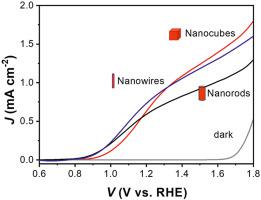International Journal of Hydrogen Energy ( IF 7.2 ) Pub Date : 2020-09-17 , DOI: 10.1016/j.ijhydene.2020.08.230 Yujie Wang , Mingyue Rong , Jiandong Zheng , Zebao Rui

|
The morphology of hematite photoanode is a significant relevant factor in its photoelectrochemical (PEC) performance. Hematite nanowires and nanocubes as well as nanorods with intentional Sn doping were prepared by hydrothermal processes containing disparate additives. The band-gap decreases in the sequence of nanowires, nanorods and nanocubes. Compared with nanorods, nanowires show higher carrier density but a lower light absorbance. With both inhibited bulk and surface charge recombination, nanowires achieve an enhanced photocurrent. Meanwhile, it is more complicated for the charge conversion in the hematite nanocubes. Light absorption is limited due to the compact arrangement of nanocubes. Besides, nanocubes show a highly oriented (104) plane which is unfavorable to the charge conductivity. Despite the negative factors hindering its PEC performance, the extremely high carrier density in the nanocubes benefits to the distinctly enhanced photocurrent collected from the hematite samples annealed at 550 and 650 °C respectively. However, the superiority of hematite nanocubes annealed under 800 °C is restricted by the high onset potential. Still, attributed to the high surface charge transfer efficiency, the hematite nanocubes achieve the highest photocurrent among the samples at biases above 1.3 V. Electrodes made of hematite nanorods, nanowires and nanocubes annealed at 800 °C achieve a photocurrent of 1.01, 1.30 and 1.40 mA cm−2 at 1.6 V vs. RHE, respectively.
中文翻译:

赤铁矿光阳极用于光电化学水分解的形态控制
赤铁矿光阳极的形态是其光电化学(PEC)性能的重要相关因素。通过含有不同添加剂的水热法制备了有意掺入锡的赤铁矿纳米线和纳米立方体以及纳米棒。带隙在纳米线,纳米棒和纳米立方体的序列中减小。与纳米棒相比,纳米线显示出更高的载流子密度,但光吸收率更低。由于抑制了本体和表面电荷的重组,纳米线实现了增强的光电流。同时,赤铁矿纳米立方体中的电荷转换更为复杂。由于纳米立方体的紧凑排列,光吸收受到限制。此外,纳米立方体显示出高度取向的(104)平面,这不利于电荷传导性。尽管有不利的因素阻碍了其PEC性能,但纳米立方体中极高的载流子密度却有利于分别从分别在550和650°C退火的赤铁矿样品收集的光电流。但是,在800°C下退火的赤铁矿纳米晶的优越性受到高起始电位的限制。尽管如此,归因于高的表面电荷转移效率,赤铁矿纳米立方体在高于1.3 V的偏压下仍能在样品中获得最高的光电流。由赤铁矿纳米棒,纳米线和纳米立方体在800°C退火制成的电极实现的光电流为1.01、1.30和1.40。毫安厘米 高起始电位限制了在800°C下退火的赤铁矿纳米晶的优越性。尽管如此,归因于高的表面电荷转移效率,赤铁矿纳米立方体在高于1.3 V的偏压下仍能在样品中获得最高的光电流。由赤铁矿纳米棒,纳米线和纳米立方体在800°C退火制成的电极实现的光电流为1.01、1.30和1.40。毫安厘米 高起始电位限制了在800°C下退火的赤铁矿纳米晶的优越性。尽管如此,归因于高的表面电荷转移效率,赤铁矿纳米立方体在高于1.3 V的偏压下仍能在样品中获得最高的光电流。由赤铁矿纳米棒,纳米线和纳米立方体在800°C退火制成的电极实现的光电流为1.01、1.30和1.40。毫安厘米相对于RHE分别为1.6 V时的-2。



























 京公网安备 11010802027423号
京公网安备 11010802027423号